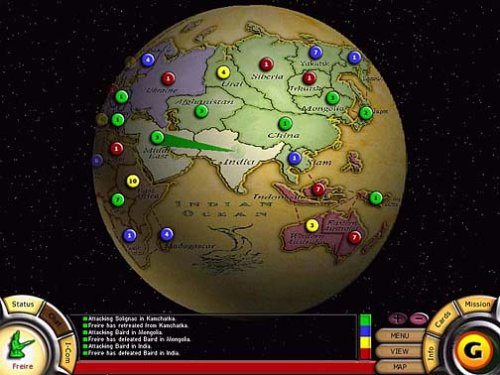
:strip_icc()/pic6467144.jpg)
Players draft new armies and then distribute these pieces to any of their territories at the beginning of their turn. There are three main phases to a player's turn: getting and placing new armies, attacking, and fortifying. One and only one army is placed on each territory before the game commences. The original rules from 1959 state that the entire deck of Risk cards (minus the wild cards) is dealt out, assigning players to the territories on their cards. As in a standard game, players still count out the same number of starting infantry and take turns placing their armies. Having done this, the actual game begins with another roll of a dice, which is used to determine the playing order.Īn alternate and quicker method of setup from the original French rules is to deal out the deck of Risk cards minus the wild cards, assigning players to the territories on their cards. Players then take turns placing their remaining armies on their territories. Players then take turns claiming territories by placing an infantry on an unoccupied territory until all the territories are occupied.


If three are playing, each player counts out 35 infantry four players, 30 infantry five players, 25 infantry six players, 20 infantry. This third set is neutral and only defends if attacked (the player not attacking rolls for the neutral armies).
HASBRO RISK 2 PLUS
If two are playing, then each player counts out 40 infantry, plus 40 more from a different color set. The number of starting armies depends on the number of players. Setup Standard Įach player first counts out a number of infantry for initial deployment. version did not have this added until 1993. While the European versions of Risk had included the variation Secret Mission Risk for some time, the U.S. Subsequent editions restored the missing route. In the 40th Anniversary Collector's Edition the movement route between the territories of East Africa and Middle East was removed this was later confirmed to be a manufacturing error, an error repeated in Risk II. Twenty-eight Mission cards also come with the game to be used in the Secret Mission Risk rule variant. Because these cards have all three symbols, they can match with any two other cards to form a set. Also included are two wild cards that depict an infantry, cavalry, and artillery piece, as opposed to one of the three and a territory. These cards can also be used for game set-up (see below for details). If a player collects either three cards with the same symbol, or one of each, these cards may be traded in for reinforcements at the beginning of a player's turn. No more than one card may be awarded per turn. One of these cards is awarded to a player at the end of each turn if the player has successfully conquered at least one territory during that turn. Forty-two of these depict territories, in addition to a symbol of an infantry, cavalry, or artillery piece. Standard equipment also includes five (originally six) dice in two colors: three red dice for the attacker, and two (originally three) white or blue dice for the defender.Īlso included is a total of seventy-two Risk cards. If a player runs out of army pieces during the game, another color may be used to substitute, or another symbolic token to help keep track of armies. These token types are purely a convention for ease of representing a specific army size. In the 2005 "bookcase" edition, playing pieces are once again wooden cubes. The 40th Anniversary Collector's Edition contained the same troop pieces but made of metal rather than plastic. The 1993 edition introduced plastic infantry tokens (representing a single unit), cavalry (representing five units), and artillery (representing ten units). In the 1980s, these were changed to pieces shaped into the Roman numerals I, III, V, and X. In the first editions, the playing pieces were wooden cubes representing one army each and a few rounded triangular prisms representing ten armies each, but in later versions of the game these pieces were molded of plastic to reduce costs. The latter were more accurate maps (northern 'Ukraine' and Greece in 'Southern Europe' are more lifelike) and the cards were better quality of material.Įach Risk game comes with a number of different colored tokens denoting armies (originally, one set each of black, blue, green, pink, red and yellow). Equipment and design File:Risk (game) territory cards.jpgĨ 'territory cards' from the 1963 UK set and the same from 1980 UK set.


 0 kommentar(er)
0 kommentar(er)
